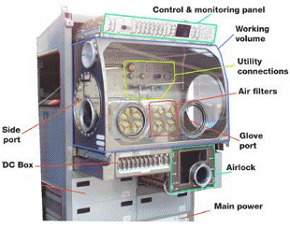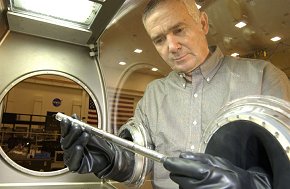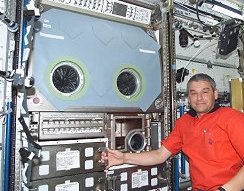|
A device delivered to the ISS in the summer
of 2002 has added something important to space station research:
the human touch.
by Dr Tony Phillips and Steve
Price
When Mary Etta Wright was a child,
she loved to experiment. She mixed powders from her chemistry set,
took apart the family radio … and, oh yes, there was that time when
she dropped (and shattered) her father's piggy bank. "It seemed
I was always getting in trouble," laughs Wright. "But touching things
was how I learned about them."
Now Wright, who works at NASA's Microgravity
Development Lab at the Marshall Space Flight Centre, is helping
astronauts get their hands on things, too. She's the lead engineer
for the Microgravity Science Glovebox - a device that will allow
astronauts to reach in and touch some of the amazing experiments
onboard the International Space Station (ISS) .
"Humans are natural scientists," says
Wright. "We can observe, react to the unexpected and tinker with
things to squeeze the most out of any experiment." Yet until now,
that was often impossible on the ISS. Many experiments took place
inside sealed compartments, and reaching in was not allowed.
The barriers were for the crew's own
good. Liquids in zero-g, for example, don't always stay in their
test tubes. And if fumes get thick, astronauts can't throw open
the nearest window for fresh air. Floating contaminants pose a danger
to the crew and to the station itself - they must be contained.
Scientists needed something that would
keep contaminants in ... yet not keep astronauts out. The solution
is the ESA-built Microgravity Science Glovebox, or "MSG" as it's
known around NASA.

A diagram
of the Microgravity Glovebox
|
The glovebox is a tightly sealed aluminium
chamber ... with hands. "The MSG is about the size of a spacious
juke box," says Wright. There's room for experiments as large as
255 liters (67 gallons). Astronauts can reach into the chamber using
rubber gloves attached to the front and sides. Large windows made
of Lexan (a tough plastic widely used on Earth for items ranging
from water bottles to bus stops) provide a clear view of what's
happening inside.
"It's a beautiful setup, like a small
laboratory," says Aleksander Ostrogorsky, a professor at the Rensselaer
Polytechnic Institute who will soon use the glovebox to study semiconductors.
The glovebox is laid out much like
a traditional lab bench. There are power supplies, vacuum ports
and computer interfaces. The familiar arrangement helps scientists
design space-experiments using their own lab benches on Earth. Human
participation allows for simpler designs. Experiments can be developed
for the glovebox within two to three years at a fraction of the
cost of totally automated systems
This isn't the first time a glovebox
has flown to space. Astronauts have used them on NASA's space shuttle
and on the Russian space station Mir. But the MSG is bigger and
better than its predecessors in many ways. For example, cameras
mounted inside the MSG can transmit live images to Earth, where
scientists can monitor and even control their own experiments. As
a result, astronauts and scientists form a team of creative, brain-storming
co-workers - "something we couldn't do before," says Wright.

On Earth,
Aleksander Ostrogorsky peers into the MSG through its large
clear windows.
|
Scientists are looking forward to using
the MSG for many things - to probe the physics of fluids, the strange
behaviour of flames, the inner workings of cells, the growth of
tissues ... the list goes on and on. Some of
the experiments slated for flight are so cutting-edge they sound
more like science fiction than ordinary science.
Imagine, for example,
a fluid that stiffens when you hold a magnet near it, and softens
again when the magnet goes away. Sounds amazing, but it's a real
effect. An upcoming experiment called InSPACE will use the glovebox
to explore these exotic liquids, called "magnetorheological fluids."
The possibilities are
mind-boggling: In theory, surfaces coated with such fluids could
change form at the bidding of magnetic controls. A single magnetorehelogical
mould could cast an infinite variety of shapes. Book makers could
publish magnetic texts in Braille - as easily scrolled and edited
as words on a computer screen. Medical engineers could build magnetorheological
limbs that bend and move as if alive.

Valery Korzun, the commander of the International
Space Station (Expedition
5), floats beside the newly-installed Microgravity Science
Glovebox
|
"But first," cautions Jack Lekan, the project manager for InSPACE
at the Glenn Research Centre, "we have to learn more about the basic
physics of these fluids." That's what InSPACE aims to do.
During the experiment,
astronauts will observe what happens when a floating magnetorehelogical
fluid is exposed to magnetic pulses. To collect the data scientists
need, astronauts will reach into the glovebox to align and focus
cameras on a spot only 0.2 mm wide. If a fluid bubble gets in the
way of the shot ... flick! they can remove it. "Astronauts are an
integral part of our study," says Lekan.
Shuttle Endeavour (STS-111)
delivered the glovebox to the space station this week - good news
for scientists on Earth and for the station's crew. Says Wright:
"astronauts love doing hands-on experiments." And now they can.
Note - The Microgravity Science Glovebox
was built for NASA by the European Space Agency (ESA). In exchange,
the ESA will be able to use other facilities inside the Destiny
lab until that agency's own laboratory – the Columbus Orbital Facility
– is attached to the space station in a couple of years.
|
